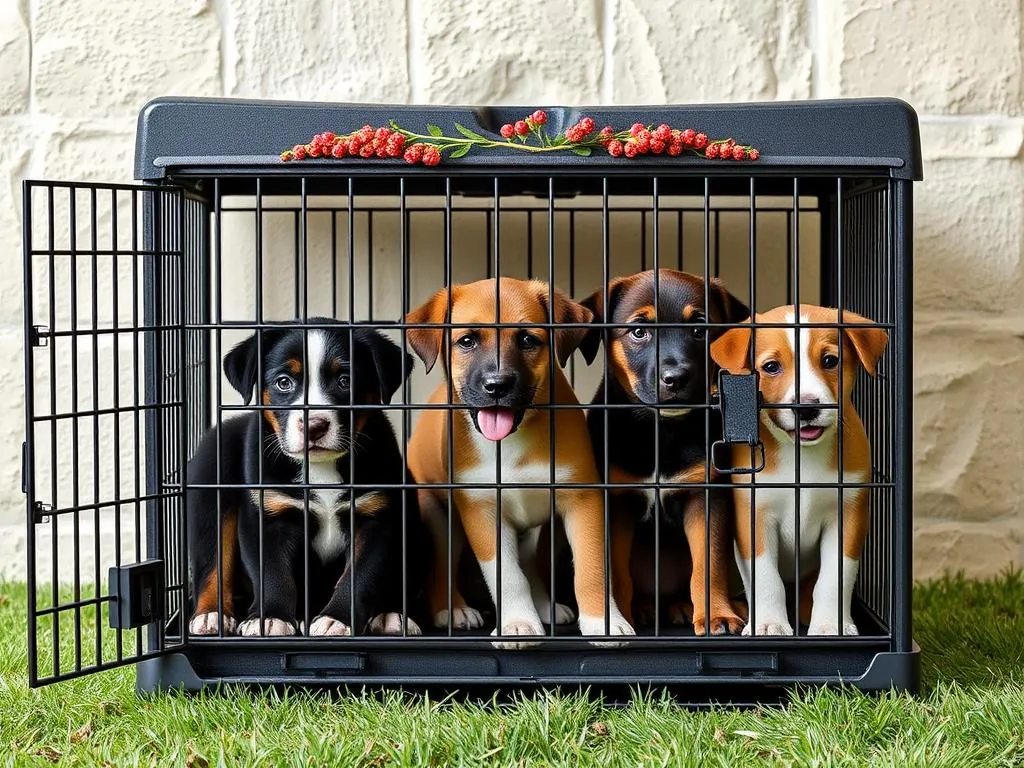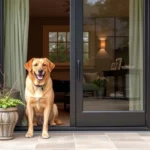
Introduction
Crate training is an essential part of bringing a new puppy into your home. Not only does it provide a safe and secure environment for your puppy, but it also plays a significant role in house training. When done correctly, crate training helps puppies develop a sense of comfort and security, reducing anxiety and preventing destructive behavior. Choosing the best crates for puppies is crucial in this training process, as the right crate can make all the difference in how your puppy adapts to their new home.
Understanding Puppy Crates
What is a Puppy Crate?
A puppy crate is a confined space designed to provide safety and security for your furry friend. It serves as a den-like environment where puppies can retreat when they need a break. Crate training helps establish a routine, making house training easier and more effective.
Types of Puppy Crates
When selecting the best crates for puppies, understanding the different types available is essential.
-
Wire Crates: These crates are made of metal and provide excellent ventilation. They are sturdy and often come with a divider to accommodate a puppy’s growth. However, they may not be the most comfortable option for long periods.
-
Plastic Crates: Also known as airline crates, these are made from durable plastic and provide a more enclosed space, which can be comforting for some puppies. They are lightweight and often easy to clean but may lack ventilation.
-
Soft-Sided Crates: These are made from fabric and are ideal for travel due to their lightweight and portable nature. However, they may not be suitable for strong or chewer puppies.
-
Wooden Crates: These are aesthetically pleasing and can blend seamlessly into home decor. They are often more expensive and may require additional features for proper ventilation.
| Type | Durability | Portability | Comfort |
|---|---|---|---|
| Wire Crates | High | Medium | Medium |
| Plastic Crates | Medium | High | Medium |
| Soft-Sided Crates | Low | High | High |
| Wooden Crates | High | Low | Medium |
Factors to Consider When Choosing a Puppy Crate
Size and Space Requirements
Choosing the right size crate is vital for your puppy’s comfort. Puppies should have enough space to stand, turn around, and lie down comfortably. Measure your puppy from nose to tail and from the ground to the top of their head when standing. This measurement will help you find the perfect fit.
- Small Breeds: Crates for small breeds like Chihuahuas or Yorkshire Terriers should be compact.
- Medium Breeds: Breeds such as Beagles or Bulldogs will require a mid-sized crate.
- Large Breeds: For larger breeds like Golden Retrievers or German Shepherds, opt for larger crates that can accommodate their growth.
Material and Durability
Different materials come with their pros and cons.
- Wire Crates: Durable and easy to clean, but can be cold and uninviting.
- Plastic Crates: Offer a safe space but may not be as long-lasting if chewed.
- Soft-Sided Crates: Great for travel but not ideal for puppies that chew or scratch.
- Wooden Crates: Stylish and durable but may require maintenance.
Ventilation and Visibility
A well-ventilated crate with visibility can help reduce anxiety. Puppies need to see their surroundings and feel airflow to stay comfortable. Wire crates generally provide the best ventilation, while plastic crates offer limited airflow unless they have ventilation holes.
Portability and Weight
If you plan to travel with your puppy, consider a lightweight and easily collapsible crate. Soft-sided crates excel in this area, while wire and plastic crates may be heavier but offer more durability.
Safety Features
Safety is a top priority when selecting the best crates for puppies. Look for crates made from non-toxic materials, with secure latches and escape-proof designs. Avoid crates with sharp edges or removable parts that could pose a choking hazard.
Top 5 Best Crates for Puppies
Crate #1: MidWest Homes for Pets iCrate
Description: A versatile wire crate that comes in various sizes, perfect for growing puppies.
Key Features:
– Double door design for easy access.
– Divider panel included for adjusting space as your puppy grows.
– Durable metal construction.
Pros:
– Easy to assemble and disassemble.
– Excellent ventilation and visibility.
– Affordable price range.
Cons:
– May require additional bedding for comfort.
– Some puppies may escape if not properly secured.
Price Range: $50 – $100
Crate #2: Petmate Vari Kennel
Description: A sturdy plastic crate ideal for travel and home use.
Key Features:
– Airline-approved for pet travel.
– Heavy-duty construction with ventilation holes.
– Easy to clean and maintain.
Pros:
– Provides a secure, den-like environment.
– Lightweight and portable.
– Comes in multiple sizes.
Cons:
– Limited visibility compared to wire crates.
– May not withstand heavy chewing.
Price Range: $60 – $120
Crate #3: EliteField 3-Door Folding Soft Dog Crate
Description: A lightweight and portable soft-sided crate perfect for travel.
Key Features:
– Three doors for easy access.
– Durable fabric with mesh windows for ventilation.
– Comes with a carrying bag for convenience.
Pros:
– Easy to set up and take down.
– Great for indoor and outdoor use.
– Comfortable for puppies.
Cons:
– Not suitable for aggressive chewers.
– Limited durability compared to wire or plastic crates.
Price Range: $40 – $80
Crate #4: PetFusion BetterBox Dog Crate
Description: A stylish wooden crate that doubles as furniture, perfect for home use.
Key Features:
– Stylish design that blends with home decor.
– Ventilation holes and removable top for easy cleaning.
– Sturdy construction.
Pros:
– Attractive and functional.
– Provides a cozy space for puppies.
– Highly durable.
Cons:
– Heavier and less portable.
– Higher price point compared to other options.
Price Range: $150 – $300
Crate #5: AmazonBasics Folding Metal Dog Crate
Description: A budget-friendly option that offers solid performance.
Key Features:
– Double door design for easy access.
– Divider panel included for adjusting space.
– Easy to clean with removable bottom tray.
Pros:
– Affordable and reliable.
– Good ventilation and visibility.
– Easy to assemble.
Cons:
– Basic design may not be suitable for all aesthetics.
– Puppies may need additional bedding for comfort.
Price Range: $40 – $90
How to Properly Introduce Your Puppy to Their Crate
Preparing the Crate
Before introducing your puppy to their crate, set it up properly. Add comfortable bedding and a few toys to make it inviting. The crate should feel like a safe haven, not a prison.
Positive Reinforcement Techniques
Use treats and praise to encourage your puppy to enter the crate. Toss a treat inside, and when they go in to retrieve it, praise them enthusiastically. This positive reinforcement will help them associate the crate with good experiences.
Gradual Crate Training Steps
Start by allowing your puppy to explore the crate with the door open. Gradually increase the time they spend inside, beginning with just a few minutes and working up to longer periods. Always ensure they feel comfortable and secure during this process.
Common Mistakes to Avoid
Avoid using the crate as a form of punishment. This can create negative associations and lead to anxiety. Additionally, never ignore signs of distress. If your puppy is crying or showing signs of discomfort, check on them and reassure them.
Frequently Asked Questions (FAQs)
How long can a puppy stay in a crate?
Puppies should not be crated for more than a few hours at a time. As a rule of thumb, a puppy can hold their bladder for one hour for every month of age. For example, a three-month-old puppy should be crated for no more than three hours.
Should I cover the crate?
Covering the crate can create a den-like environment, making it feel safer for some puppies. However, not all puppies prefer this. Observe your puppy’s behavior and adjust accordingly.
What if my puppy cries in the crate?
If your puppy cries, it may be due to fear or discomfort. Check to ensure they have enough bedding and toys, and try to reassure them without letting them out immediately. If the crying continues, it may be worth consulting a professional trainer.
Can I use a crate for long-term housing?
While crates can be a safe space for puppies, they should not be used as long-term housing. Puppies need room to exercise and play, so they should have designated time outside of the crate each day.
Conclusion
Choosing the best crates for puppies is a fundamental step in ensuring a smooth transition into their new home. Remember that the right crate will not only provide safety and comfort but will also aid significantly in training. Assess your puppy’s needs and preferences before making a decision. Your experience with crate training can be a rewarding journey for both you and your puppy. Share your thoughts and experiences, or feel free to ask questions about puppy crates!









